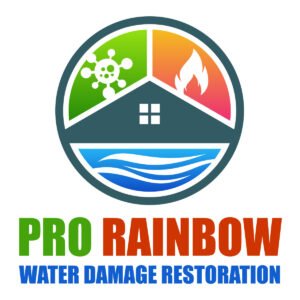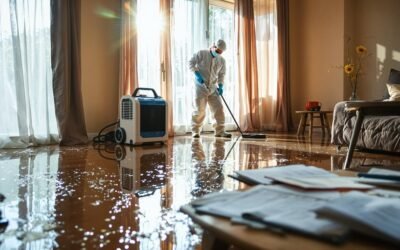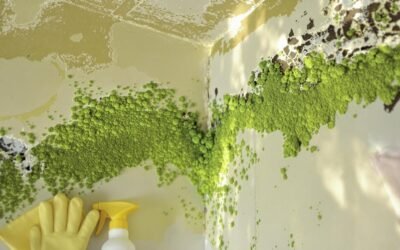To identify whether you're facing mold or water damage, look for specific indicators. Mold typically appears as black, green, or white patches in damp areas, often accompanied by a musty odor. Water damage, on the other hand, manifests as visible stains, bubbling paint, or warped floors because of leaks. Check for excessive humidity or pooling water, which signals urgent attention. Early intervention is vital, as mold can develop quickly after water exposure. Understanding these signs will help you tackle the underlying issue effectively and guarantee a safer living environment. You'll find out more about prevention and remediation techniques next.
Key Takeaways
- Mold typically appears as black, green, or white patches in damp areas, while water damage manifests as visible stains or bubbling paint.
- Musty odors often indicate hidden mold presence, whereas water damage is accompanied by signs like pooling water or warped floors.
- Water damage can lead to mold growth if not addressed swiftly, as mold can develop within 24-48 hours of water exposure.
- Regular inspections of plumbing and roofs help identify potential water damage before it leads to mold issues.
- Professional assessment is necessary for extensive mold growth or significant water damage to ensure proper remediation and safety.
Understanding Mold Growth

How does mold thrive in your home? Mold growth hinges on its lifecycle, which includes spores, germination, and reproduction. Favorable environmental factors play an essential role; mold requires moisture, warmth, and organic materials to flourish. When humidity levels exceed 60% and temperatures range between 60°F and 80°F, you create an ideal setting for mold to develop.
Once spores land on a suitable surface, they can absorb moisture and begin to germinate, leading to rapid growth. As the mold reproduces, it releases more spores, perpetuating the cycle. Understanding these elements helps you recognize potential mold threats and take proactive measures to maintain a healthy environment. By controlling humidity and ensuring proper ventilation, you can disrupt the mold lifecycle and minimize growth. Additionally, effective solutions tailored to specific mold scenarios can further enhance your mold prevention efforts.
Common Causes of Water Damage
While water damage can stem from various sources, understanding these common causes is vital for prevention and mitigation. One frequent culprit is leaky pipes, which can occur because of corrosion, wear, or improper installation. Even small leaks can lead to significant damage over time, so it's important to monitor your plumbing regularly. Roof leaks are another major source of water damage, often resulting from damaged shingles, poor drainage, or flashing issues. Rainwater can seep into your home, leading to structural damage and mold growth if not addressed promptly. Additionally, prompt water removal is essential to minimize damage and prevent further issues. By being aware of these causes, you can take proactive steps to inspect your home, repair any issues, and safeguard against potential water damage before it becomes a costly problem.
Signs of Mold Infestation
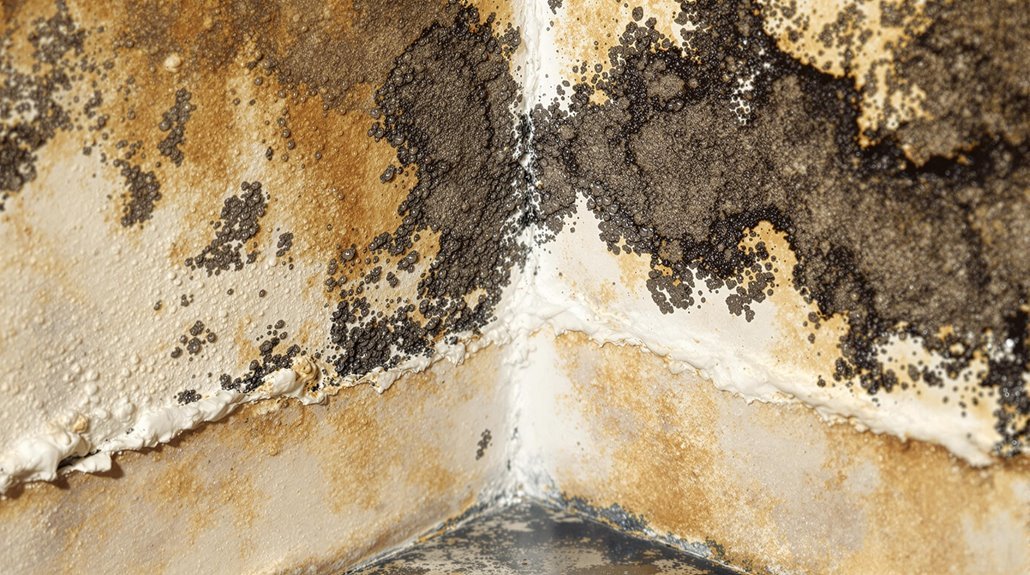
If you suspect water damage in your home, it's vital to recognize the signs of mold infestation early. Look for visible mold growth, which can appear as black, green, or white spots on surfaces. Familiarize yourself with common mold types, such as Aspergillus and Stachybotrys, as they can pose health risks. Pay attention to musty odors, as they often indicate hidden mold. Check for water stains or discoloration on walls and ceilings, which may signal moisture presence. You should likewise monitor for excessive humidity, especially in basements and bathrooms. If you identify these signs, prompt mold removal is imperative to prevent further damage and health issues. Addressing mold quickly can save you time, money, and potential health concerns.
Indicators of Water Damage
When evaluating your space for water damage, look for visible water stains on walls or ceilings, as they can indicate underlying issues. Furthermore, if you notice musty odors, it's often a sign that moisture accumulation has occurred. Recognizing these indicators early can help you mitigate further damage and prevent mold growth.
Visible Water Stains
Visible water stains serve as clear indicators of underlying water damage in your home. When you notice these stains, pay attention to the water stain patterns and their locations. For instance, stains that appear in a circular shape on your ceiling often indicate leaks from above. Ceiling discoloration can vary in color, from light yellow to dark brown, which can help you assess the severity of the water damage. Moreover, the size and spread of the stains can provide insight into how long the issue has persisted. Addressing these stains promptly is essential, as they not only signal water damage but also create an environment favorable to mold growth if left untreated. Always investigate the source of these stains to prevent further complications.
Musty Odors Present
Musty odors often accompany visible water stains, signaling potential water damage in your home. These musty smells typically arise from damp materials and hidden moisture, which can encourage mold growth. Identifying the sources of these odors is essential for effective remediation.
| Odor Source | Possible Causes | Action Required |
|---|---|---|
| Wet drywall | Leaky pipes | Inspect and repair leaks |
| Damp carpets | Flooding or spills | Replace or dry thoroughly |
| Musty basements | Poor ventilation | Improve airflow and dehumidify |
| Attic insulation | Roof leaks | Repair roof and replace insulation |
Health Risks Associated
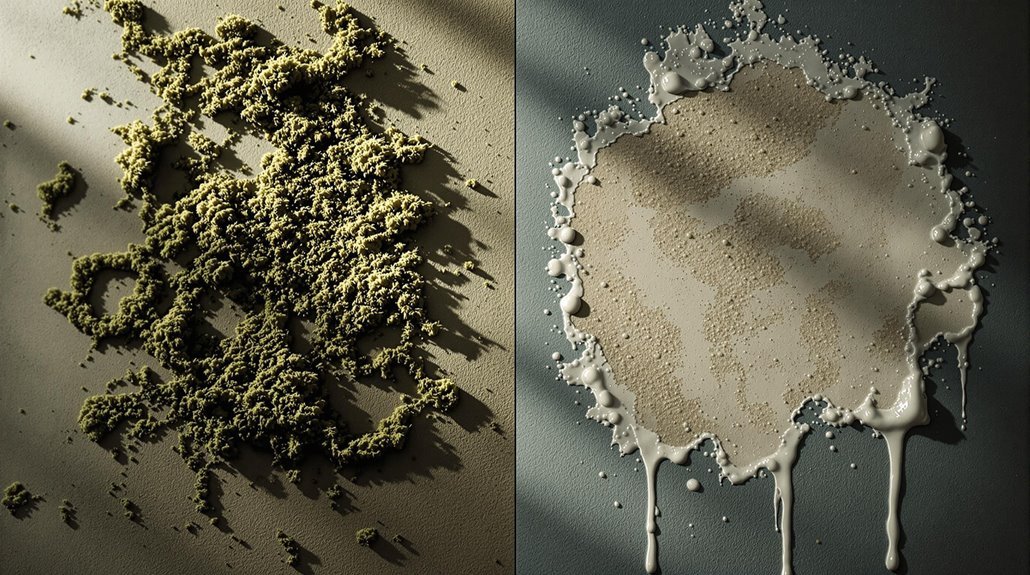
Although mold and water damage may seem like separate issues, they often intertwine, leading to significant health risks. Mold exposure can trigger mold allergies, causing symptoms like sneezing, itchy eyes, and skin rashes. For individuals with preexisting conditions, such as asthma, the presence of mold can intensify respiratory issues, making it difficult to breathe. Additionally, prolonged exposure to mold spores can lead to chronic respiratory conditions and infections, particularly in vulnerable populations like children and the elderly. Water damage itself can create an environment favorable to mold growth, compounding these health risks. Recognizing the relationship between these two issues is essential for maintaining a healthy living space and preventing long-term health complications.
Preventing Mold and Water Damage
To prevent mold and water damage, you need to prioritize regular inspections and maintenance of your property. Implementing proper ventilation techniques can greatly reduce moisture buildup, a key factor in mold growth. By staying proactive, you can safeguard your home from these damaging issues.
Regular Inspections and Maintenance
Regular inspections and maintenance are essential for preventing mold and water damage, as they allow you to identify potential issues before they escalate. By implementing routine checks, you can adopt preventive measures to safeguard your home.
| Inspection Type | Frequency | Key Focus Areas |
|---|---|---|
| Roof Inspection | Annually | Shingles, leaks |
| Plumbing Check | Bi-Annually | Pipes, fittings |
| Basement Inspection | Quarterly | Moisture, drainage |
| HVAC System Check | Seasonally | Filters, condensation |
| Exterior Maintenance | Monthly | Gutters, landscaping |
Staying proactive with these inspections can help you manage risks effectively, ensuring a safe and healthy living environment. Don't wait until problems arise—regular maintenance saves time and money in the long run.
Proper Ventilation Techniques
While you may not think about it often, proper ventilation techniques are crucial in preventing mold and water damage in your home. Effective humidity control starts with ensuring adequate air circulation throughout your space. Open windows when weather permits, and use exhaust fans in areas prone to moisture, like kitchens and bathrooms. Consider installing a dehumidifier in damp spaces to maintain ideal humidity levels. Regularly check and clean vents to prevent blockages that hinder airflow. Furthermore, keeping doors open between rooms allows for better air movement, which can help reduce moisture buildup. By prioritizing these ventilation practices, you can greatly lower the risk of mold growth and water damage, ensuring a healthier living environment for you and your family.
Remediation Techniques
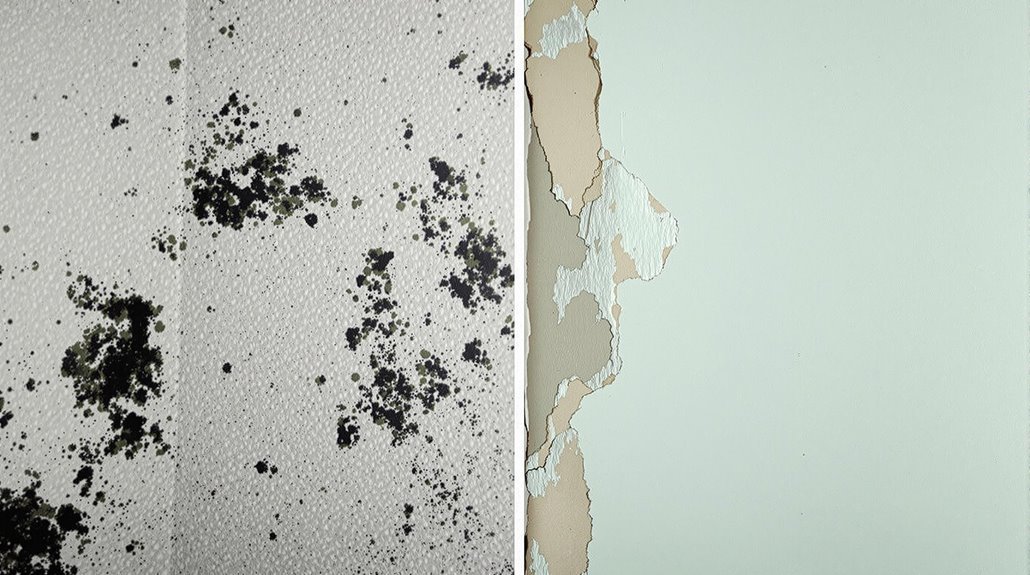
Effective remediation techniques are crucial for addressing mold and water damage in any space. To effectively tackle these issues, consider the following remediation methods:
- Identify the Source: Locate and fix the source of moisture to prevent further damage.
- Containment: Seal off affected areas to avoid spreading mold spores during mold removal.
- Cleaning and Removal: Use proper cleaning solutions to eliminate mold from surfaces; porous materials may need replacement.
- Drying and Dehumidification: Guarantee thorough drying of the area to inhibit mold regrowth.
When to Call Professionals
When should you consider bringing in professionals for mold or water damage issues? If you notice extensive damage, persistent odors, or health symptoms, it's time for a professional assessment. Quick emergency response can mitigate further harm, especially with water damage that can lead to mold growth within 24-48 hours.
| Signs to Call Professionals | Action Needed |
|---|---|
| Extensive water accumulation | Emergency response required |
| Visible mold growth | Professional assessment crucial |
| Structural damage observed | Immediate expert intervention needed |
| Unresolved odors | Assessment for hidden mold required |
| Health issues in occupants | Professional evaluation necessary |
Don't hesitate to seek help; early intervention can save costs and protect your health.
Conclusion
In summary, recognizing the differences between mold and water damage is essential for effective remediation. For instance, imagine you uncover a musty smell in your basement. By investigating further, you might find water stains on the walls, indicating a leak that's fueled mold growth. Addressing the leak promptly would prevent further mold development and protect your health. Stay vigilant and proactive; identifying these issues early can save you time, money, and potential health risks down the line.
